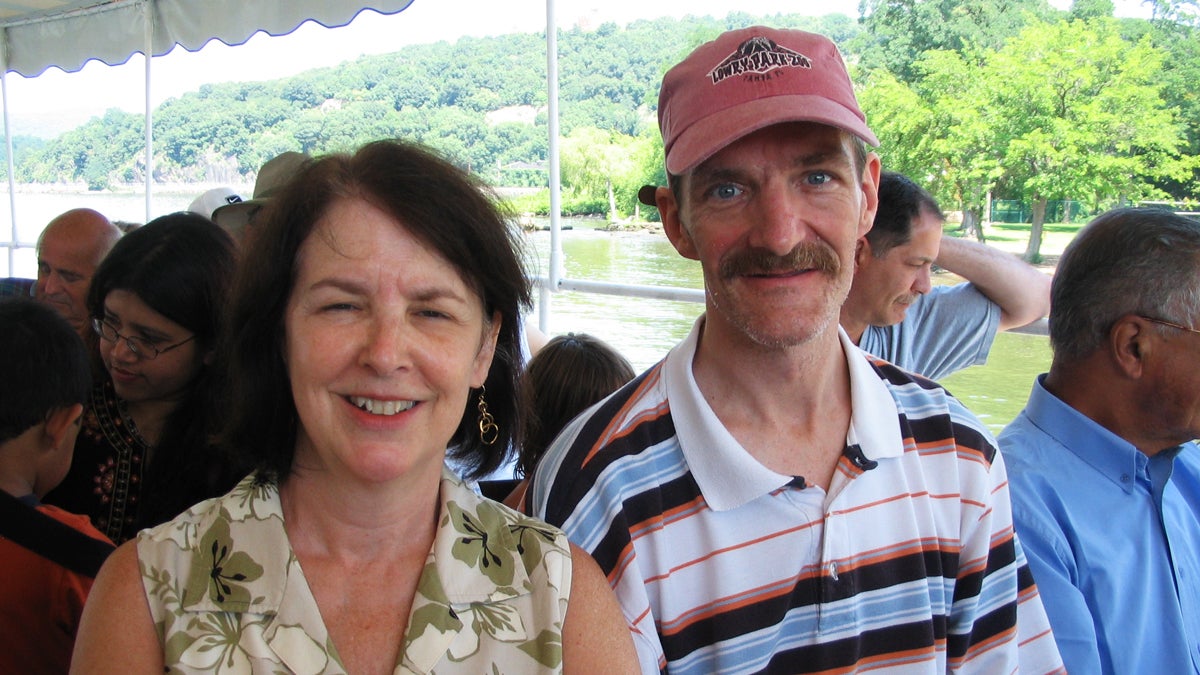How to get help when you don’t believe you need it
Listen
Katherine Flannery Dering and her brother Paul in 2007. (Courtesy of Katherine Flannery Dering)
Just outside of New York City in a farmhouse in Bedford, New York, Katherine Flannery Dering is looking at photos of her brother, Paul. Paul is one of her 10 siblings, but he stands out among them.
Dering was 12 when Paul was born. She remembers him as the kid who would come running out to say “hi” when she came home from college. She describes him as a handsome boy, about 6’1″, with blonde hair and “startling blue eyes.” He was on the football team, but she said he was also a very sentimental kid.
“He wasn’t afraid to come over and hug you.”
A life, falling apart
Paul died eight years ago, when he was 48 years old. And even when he was dying, he didn’t know he was ill.
“He’d been told he had cancer but he said he didn’t have cancer,” said Dering. “He said he had bad acne, which he swallowed and it got into his lungs and if he would just cough it out, he would get better.”
Paul did have cancer, and he also had schizophrenia. He was diagnosed when he was 16, but he never acknowledged it. He told people he’d been shot in the head.
Paul spent most of his life in inpatient care facilities from the 1970s until the 1990s, when states shut down these psychiatric hospitals. He was released to live on his own where, without constant care and medication, his mental and physical health declined. Dering recalled that he became unstable and unpredictable. He was so consumed with his own thoughts that he lost the ability to care for himself, barely eating and not cleaning himself or his home.
He maintained that his unstable behavior was from external factors, like being shot in the head.
Her brother sufferered from a condition known as anosognosia– the inability to recognize one’s own illness. It’s very common in people with schizophrenia.
Unaware of illness, refusing to get help
Doctors have been aware for centuries that some people are blind to their own ailments, but the person who coined the term ‘anosognosia’ was the French neurologist Joseph Babinski.
In the early 1900s, Babinski treated two partially paralyzed patients, each of whom was unable to move her left arm. When asked to do so, one woman acted as if the question had not been asked; the other insisted that she had done it. Babinski called this lack of awareness anosognosia. Experts now recognize it in conditions as diverse as Alzheimer’s disease, brain injury and anorexia.
Experts don’t know for sure what causes anosognosia, but they have noticed that it involves an imbalance between the two halves of the brain, the hemispheres.
Psychiatrist Philip Gerretsen, a researcher at the Centre for Addiction and Mental Health in Toronto, said the setup is like a twin propeller plane.
“If you think of each propeller as representing one of the brain’s hemispheres, the two work in tandem or work together to help the plane fly in the proper way,” he said.
“Now in a healthy brain, things tend to be smooth moving along in the right direction. Whereas in anosognosia, one of the brain hemispheres is underactive and then veers the brain, or the plane, in the wrong direction.”
In a recent study, Gerretsen and his team asked people with schizophrenia to ungergo brain scans while answering a list of questions. Things like: Do you have schizophrenia? Are you mentally well? Is the devil’s voice real? Do you need treatment?
Those who had the most trouble distinguishing thoughts from reality tended to have asymmetrical activity in their brains, with the left hemisphere working harder than the right.
Gerretsen speculates that a factor in this phenomenon is the brain chemical dopamine. Often called the happiness hormone, dopamine pulses through the brain when people fall in love or eat a satisfying meal. But Gerretsen said that dopamine also assigns levels of importance to our experiences. And when dopamine goes haywire, as in a brain with anosognosia, neutral occurrences, such as the glance of a stranger, can take on too much significance.
“They have these strong beliefs that they are being, say, followed by the Mafia or someone is persecuting them and in those contexts dopamine seems to be assigning a higher level of meaning to these thoughts than it otherwise should be.”
Dissecting your own thoughts
“Sometimes the things your brain is telling you are happening aren’t actually happening,” said Michael Hedrick, who writes about living with schizophrenia for The New York Times, The Washington Post, Scientific American among others.
“For instance, if you walk into some store or some restaurant and you believe people are talking about you or you hear laughter and you believe that laughter is about you,” he said. “Sometimes it is really hard to separate that belief, that paranoia, that delusion from reality.”
Hedrick was diagnosed with schizophrenia 10 years ago when he was 20, and said it’s been a wild ride.
“Even now I can’t trust entirely what my brain is saying to me. It’s kinda like I have two levels of consciousness…I have my conscious self that knows what’s going on and I have my crazy brain which tells me things and I’m able to dispute what my crazy brain is telling me in my conscious brain.”
Michael got on medication when he was first diagnosed and has stayed on his medication ever since. He said he believes it is why, unlike many people, he is able to have insight into his illness. But he also said the only reason he got on medication in the first place was to get out of the hospital after his initial episode.
“I figured if I took my meds they’d see I was improving and they would let me out,” he said. But he actually was improving.
Michael said he has not had a relapse since, and said he feels lucky he got medication at an early age. He thinks it’s why he is able to function better than people like Paul who have had years of inconsistent care.
When Michael was first showing signs of schizophrenia, he believed he was a prophet sent here to establish world peace. He said his parents knew something was wrong when he started telling them about his mission, and he was frustrated that they didn’t believe him.
“I wanted them to understand so badly but they knew something was wrong and they took me to the hospital,” he said.
“It felt like betrayal for them to do that, but I can see clearly now…It’s hard to explain any of that to anyone who is normal.”
Helping families help their loved ones
This is where many families face problems getting help; communicating with a with a loved one when that person is divorced from reality.
“There’s really no reason to keep throwing gasoline on the fire of this conflict,” said psychologist Xavier Amador.
Amador is the author of many books including one entitled, “I ‘m not sick, I don’t need help.” He’s also the founder of the LEAP Institute. Which stands for: Listen, Empathize, Agree and Partner.
Trying to force a person with anosognosia to see things the way they really are only deepens the rift. Instead, Amador encourages caretakers to acknowledge the sick person’s version of events, and to make suggestions, not proclamations.
“I wouldn’t want treatment for an illness I don’t believe I have.”
He said the goal is to find common ground. Once a trusting relationship has been re-established, it’s more likely the person will take advice and make better, autonomous, decisions. Like getting on and staying on medication.
Grieving, remembering, and advocating for change
Katherine Dering said her brother Paul had been out of constant care for so long, she was never able to get him back on track. Eventually his health severely diminished. He developed pneumonia and was put into a nursing home where he was later diagnosed with lung cancer.
“When someone dies, you grieve them,” said Katherine. “But if they don’t die — if they have schizophrenia and they don’t acknowledge they are even sick and do bizarre things and disrupt every family gathering — you’re in a constant state of grieving. You never get over it because they are still there.”
One of the last times the Flannery siblings got together was on St. Patrick’s Day in March of 2008. Paul died a few months later on May 1.
Today, Katherine is doing advocacy work for families dealing with mental illness. She goes to conventions and seminars with her sister Ilene, Paul’s twin. They dress up as Nellie Bly and Dorothea Dix, two women critical in mental health activism at the turn of the century and carry posters reading: “Schizophrenia: It’s medical not behavioral” with pictures of Paul.
Dering brings posters and signs when she is advocating at conventions. One headline stands out. It says, “I Was A Person.” The poster features two pictures of Paul, one at his 9th grade graduation and the other taken when he was only 48. He looks about 80, scrawny and toothless. But Dering wants people to see the person she loved.
“He was pretty looney at times but he was a person,” she said.
Katherine wrote a book about Paul’s life called “Shot in the Head,” and doctors are taking steps every day to figure out ways to help people like him.
Tearing up, she describesd one of her favorite memories of Paul. One day they drove up to a lookout point to watch eagles together. As they were standing there, Paul brought up reincarnation.
“I asked him, ‘Does he want to come back as one of these eagles?’ And he said, ‘I’d just like to come back as one of the sane ones’.”
WHYY is your source for fact-based, in-depth journalism and information. As a nonprofit organization, we rely on financial support from readers like you. Please give today.



